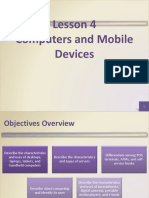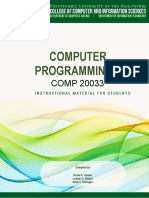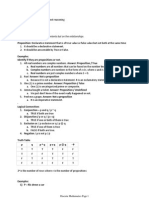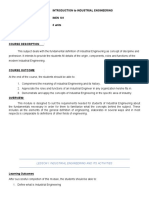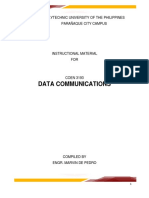Computer Fundamentals and Programming - Module 01
Uploaded by
Joel ManacmulComputer Fundamentals and Programming - Module 01
Uploaded by
Joel ManacmulModule 01
Computer Fundamentals
and Programming
ENGR. JOEL D. MANACMUL
Department of Engineering and Architecture
Bataan Heroes College
This module or any portion thereof may not be reproduced or used in any manner whatsoever without
the express written permission of the publisher except for educational purposes but with a citation to this
source.
For Permission: Contact Bataan Heroes College, Roman Super Hi-way, Balanga City, Bataan, Philippines
Computer Fundamentals and Programming Page 2 of 22
Engr. Joel D. Manacmul
Bataan Heroes College
Course Information
Course Title : Computer Fundamentals and Programming
Program : Business & Technology
Course Code : Comp 101
Credit Units : 3 units
Pre-requisite/s :
Instructor Information
Name : Engr. Joel D. Manacmul
Contact Information
Contact Number : 09281421172
Facebook : Joel Manacmul
Email : hoel07@gmail.com
Course Description
In the course, students would understand the basic components of computers (hardware and
software), information systems, and electronic data processing. The course emphasizes on program
development, which includes use of pseudocode in problem-solving and formulation of
algorithms. High level language and programming applications like C++; computer solutions of
engineering problems. .
Intended Learning Outcomes
Identify various computer applications
Familiarize with the operations or process in computer from raw facts to useful output
Explain the characteristics of input/output and storage components of computer
Know the difference and relevance of software and hardware
Computer Fundamentals and Programming Page 3 of 22
Engr. Joel D. Manacmul
Bataan Heroes College
Course Schedule
Week Topic
Basic Components of Computer
o Definition of computer
Week 1 o Computer Application
Module 1 o Operations in computer
o Components of computer
Hardware and Software
Introduction to Programming
Week 2 o What is C++
Module 2 o Installation
o Coding
MIDTERM ASSESSMENT
Week 3 Operators in C++
Module 3 Conditional Statements
Week 4
Loop Statements
Module 4
Week 5
Array
Module 5
FINAL ASSESSMENT
Computer Fundamentals and Programming
Objectives:
Working on this module should help you to:
Code basic C++ language.
Demonstrate familiarity with major events in computer history and apply their lessons to
current and future technological and social developments.
Apply problem-solving and critical-thinking skills in collaborative contexts.
Utilize technology in pursuit of intellectual growth and efficacious human interaction.
Explore and research applications of computers and computing in their daily lives.
Computer Fundamentals and Programming Page 4 of 22
Engr. Joel D. Manacmul
Bataan Heroes College
Reference
Learn Computer Fundamentals basic of Computers. Tutorial Points. Retrieved July 29, 2020 from
https://www.tutorialspoint.com/computer_fundamentals/index.htm
Parson , J. Oja, D. (2011). New Pespective on Computer Cocpets 2012: Comprehensive (14th ed).
Massachusetts, USA: Course Technology
Module 1: Components of Computer
What is Computer?
The computer is an advanced electronic device that takes raw data as input from the user and
processes it under the control of a set of instructions (called program), produces a result (output),
and saves it for future use.
Computer Applications
Computers are necessity in different area nowadays. This sub-topic will focus on different areas
of computers are used.
1. Business
A computer has high speed of calculation, diligence, accuracy, reliability, or
versatility which has made it an integrated part in all business organizations.
Computer is used in business organizations for −
• Payroll calculations
• Budgeting
• Sales Analysis
• Financial forecasting
• Managing employee database
• Maintenance of stocks, etc.
Computer Fundamentals and Programming Page 5 of 22
Engr. Joel D. Manacmul
Bataan Heroes College
2. Banking
Today, banking is almost totally dependent on computers.
Banks provide the following facilities –
Online accounting facility, which includes checking current balance, making deposits and
overdrafts, checking interest charges, shares, and trustee records.
ATM machines which are completely automated are making it even easier for customers
to deal with banks.
3. Insurance
Insurance companies are keeping all records up-to-date with the help of
computers. Insurance companies, finance houses, and stock broking firms are
widely using computers for their concerns.
Insurance companies are maintaining a database of all clients with information showing −
Procedure to continue with policies
Starting date of the policies
Next due installment of a policy
Maturity date
Interests due
Survival benefits
Bonus
Computer Fundamentals and Programming Page 6 of 22
Engr. Joel D. Manacmul
Bataan Heroes College
4. Education
The computer helps in providing a lot of facilities in the education system.
The computer provides a tool in the education system known as
CBE (Computer Based Education).
CBE involves control, delivery, and evaluation of learning.
Computer education is rapidly increasing the graph of number of computer students.
There are a number of methods in which educational institutions can use a computer to
educate the students.
It is used to prepare a database about performance of a student and analysis is carried out
on this basis.
5. Marketing
In marketing, uses of the computer are following −
Advertising − With computers, advertising professionals create art and
graphics, write and revise copy, and print and disseminate ads with the goal
of selling more products.
Home Shopping − Home shopping has been made possible through the use of
computerized catalogues that provide access to product information and permit direct
entry of orders to be filled by the customers.
6. Healthcare
Computers have become an important part in hospitals, labs, and
dispensaries. They are being used in hospitals to keep the record of patients
and medicines. It is also used in scanning and diagnosing different
diseases. ECG, EEG, ultrasounds and CT scans, etc. are also done by
computerized machines.
Computer Fundamentals and Programming Page 7 of 22
Engr. Joel D. Manacmul
Bataan Heroes College
Following are some major fields of health care in which computers are used.
Diagnostic System − Computers are used to collect data and identify the cause of illness.
Lab-diagnostic System − All tests can be done and the reports are prepared by computer.
Patient Monitoring System − These are used to check the patient's signs for abnormality
such as in Cardiac Arrest, ECG, etc.
Pharma Information System − Computer is used to check drug labels, expiry dates,
harmful side effects, etc.
Surgery − Nowadays, computers are also used in performing surgery.
7. Engineering Design
Computers are widely used for engineering purpose.
One of the major areas is CAD (Computer Aided Design) that provides
creation and modification of images. Some of the fields are −
Structural Engineering − Requires stress and strain analysis for design of ships,
buildings, budgets, airplanes, etc.
Industrial Engineering − Computers deal with design, implementation, and
improvement of integrated systems of people, materials, and equipment.
Architectural Engineering − Computers help in planning towns, designing buildings,
determining a range of buildings on a site using both 2D and 3D drawings.
8. Military
Computers are largely used in defence. Modern tanks, missiles,
weapons, etc. Military also employs computerized control systems.
Some military areas where a computer has been used are −
Missile Control
Military Communication
Computer Fundamentals and Programming Page 8 of 22
Engr. Joel D. Manacmul
Bataan Heroes College
Military Operation and Planning
Smart Weapons
9. Communication
Communication is a way to convey a message, an idea, a picture, or
speech that is received and understood clearly and correctly by the
person for whom it is meant. Some main areas in this category are −
Chatting
Usenet
FTP
Telnet
Video-conferencing
10. Government
Computers play an important role in government services. Some
major fields in this category are −
Budgets
Sales tax department
Income tax department
Computation of male/female ratio
Computerization of voters lists
Computerization of PAN card
Weather forecasting
11. Entertainment
Computer Fundamentals and Programming Page 9 of 22
Engr. Joel D. Manacmul
Bataan Heroes College
Computer systems played a major role for the entertainment industry. The
use of computers in the entertainment industry has revolutionized from
music to visual arts to interactive games and virtual simulations.
The audio file use rich compression technologies which has the most
popular format – MPEG Layer 3, or MP3. With this, audio files now have
sizes that tenth of their previous, more conventional version allowing a single CD to contain more than a
hundred songs and conveniently store songs in a computer.
Computer technology also affects how movies are created nowadays. All special effects done in movies
are practically created with the use of computers. It has the advantage of being cost and time – effective.
1.3 Operations in Computer
All types of computers follow the same basic logical structure and perform the following five
basic operations for converting raw input data into information useful to their users.
S.No. Operation Description
The process of entering data and instructions into the computer
1 Take Input
system.
Saving data and instructions so that they are available for processing
2 Store Data
as and when required.
Performing arithmetic, and logical operations on data in order to
3 Processing Data
convert them into useful information.
Output The process of producing useful information or results for the user,
4
Information such as a printed report or visual display.
Control the Directs the manner and sequence in which all of the above operations
5
workflow are performed.
Computer Fundamentals and Programming Page 10 of 22
Engr. Joel D. Manacmul
Bataan Heroes College
1. Input Unit
This unit contains devices with the help of which we enter data into the computer. This unit
creates a link between the user and the computer. The input devices translate the information into
a form understandable by the computer.
2. CPU (Central Processing Unit)
CPU is considered as the brain of the computer. CPU performs all types of data processing
operations. It stores data, intermediate results, and instructions (program). It controls the
operation of all parts of the computer.
CPU itself has the following three components −
ALU (Arithmetic Logic Unit)
Memory Unit
Control Unit
3. Output Unit
The output unit consists of devices with the help of which we get the information from the
computer. This unit is a link between the computer and the users. Output devices translate the
computer's output into a form understandable by the users.
Computer Fundamentals and Programming Page 11 of 22
Engr. Joel D. Manacmul
Bataan Heroes College
1.4 Components of Computer
1. CPU
CPU Central Processing Unit (CPU) consists of the following features −
CPU is considered as the brain of the computer.
CPU performs all types of data processing operations.
It stores data, intermediate results, and instructions (program).
It controls the operation of all parts of the computer.
CPU itself has following three components.
a. Memory or Storage Unit - This unit can store instructions, data, and intermediate results. This
unit supplies information to other units of the computer when needed. It is also known as
internal storage unit or the main memory or the primary storage or Random Access Memory
(RAM). Its size affects speed, power, and capability. Primary memory and secondary memory
are two types of memories in the computer.
b. Control Unit - This unit controls the operations of all parts of the computer but does not carry
out any actual data processing operations.
c. ALU (Arithmetic Logic Unit) This unit consists of two subsections namely,
Arithmetic Section - Function of arithmetic section is to perform arithmetic operations like
addition, subtraction, multiplication, and division. All complex operations are done by
making repetitive use of the above operations.
Logic Section - Function of logic section is to perform logic operations such as comparing,
selecting, matching, and merging of data.
Computer Fundamentals and Programming Page 12 of 22
Engr. Joel D. Manacmul
Bataan Heroes College
2. Input Devices
Following are some of the important input devices which are used in a computer −
Keyboard
Keyboard is the most common and very popular input device which helps
to input data to the computer. The layout of the keyboard is like that of
traditional typewriter, although there are some additional keys provided
for performing additional functions.
Mouse
Mouse is the most popular pointing device. It is a very famous cursor-
control device having a small palm size box with a round ball at its base,
which senses the movement of the mouse and sends corresponding
signals to the CPU when the mouse buttons are pressed.
Joystick
Joystick is also a pointing device, which is used to move the cursor position
on a monitor screen. It is a stick having a spherical ball at its both lower and
upper ends. The lower spherical ball moves in a socket. The joystick can be
moved in all four directions. The function of the joystick is similar to that of
a mouse. It is mainly used in Computer Aided Designing (CAD) and
playing computer games.
Computer Fundamentals and Programming Page 13 of 22
Engr. Joel D. Manacmul
Bataan Heroes College
Light Pen
Light pen is a pointing device similar to a pen. It is used to select a
displayed menu item or draw pictures on the monitor screen. It consists
of a photocell and an optical system placed in a small tube.
Track Ball
Track ball is an input device that is mostly used in notebook or laptop
computer, instead of a mouse. This is a ball which is half inserted and by
moving fingers on the ball, the pointer can be moved.
Scanner
Scanner is an input device, which works more like a photocopy
machine. It is used when some information is available on paper and it is
to be transferred to the hard disk of the computer for further
manipulation. Scanner captures images from the source which are then
converted into a digital form that can be stored on the disk. These
images can be edited before they are printed.
Digitizer
Digitizer is an input device which converts analog information into
digital form. Digitizer can convert a signal from the television or camera
into a series of numbers that could be stored in a computer. They can be
used by the computer to create a picture of whatever the camera had
been pointed at. Digitizer is also known as Tablet or Graphics Tablet as
it converts graphics and pictorial data into binary inputs. A graphic tablet as digitizer is used for
fine works of drawing and image manipulation applications.
Computer Fundamentals and Programming Page 14 of 22
Engr. Joel D. Manacmul
Bataan Heroes College
Microphone
Microphone is an input device to input sound that is then stored in a
digital form. The microphone is used for various applications such as
adding sound to a multimedia presentation or for mixing music.
Magnetic Ink Card Reader (MICR)
MICR input device is generally used in banks as there are large number
of cheques to be processed every day. The bank's code number and
cheque number are printed on the cheques with a special type of ink that
contains particles of magnetic material that are machine readable.
Bar Code Readers
Bar Code Reader is a device used for reading bar coded data (data in
the form of light and dark lines). Bar coded data is generally used in
labelling goods, numbering the books, etc. It may be a handheld
scanner or may be embedded in a stationary scanner.
Computer Fundamentals and Programming Page 15 of 22
Engr. Joel D. Manacmul
Bataan Heroes College
Optical Mark Reader (OMR)
OMR is a special type of optical scanner used to recognize the type
of mark made by pen or pencil. It is used where one out of a few
alternatives is to be selected and marked. It is specially used for
checking the answer sheets of examinations having multiple choice
questions.
3. Output Devices
Following are some of the important output devices used in a computer.
Monitors
Monitors, commonly called as Visual Display Unit (VDU), are the main
output device of a computer. It forms images from tiny dots, called pixels that
are arranged in a rectangular form. The sharpness of the image depends upon
the number of pixels.
Printers
Printer is an output device, which is used to print information on paper.
Two Types of Printers
1. Impact printers - print the characters by striking them on the ribbon, which is then
pressed on the paper.
Two Types of Impact Printer
a. Character printers - are the printers which print one character at a time.
Computer Fundamentals and Programming Page 16 of 22
Engr. Joel D. Manacmul
Bataan Heroes College
Dot Matrix Printer - In the market, one of the most popular
printers is Dot Matrix Printer. These printers are popular because
of their ease of printing and economical price.
Daisy Wheel - These printers are generally used for word-
processing in offices that require a few letters to be sent here and
there with very nice quality.
b. Line printers - are the printers which print one line at a time.
Two Types of Line Printer
a. Drum Printer - This printer is like a drum in shape hence it is called drum
printer. The surface of the drum is divided into a number of tracks. Total
tracks are equal to the size of the paper, i.e. for a paper width of 132
characters, drum will have 132 tracks. A character set is embossed on the
track. Different character sets available in the market are 48 character set,
64 and 96 characters set. One rotation of drum prints one line. Drum
printers are fast in speed and can print 300 to 2000 lines per minute.
b. Chain Printer – in this printer, a chain of character sets is used, hence it is
called Chain Printer. A standard character set may have 48, 64, or 96
characters.
Computer Fundamentals and Programming Page 17 of 22
Engr. Joel D. Manacmul
Bataan Heroes College
2. Non-impact Printers - print the characters without using the ribbon. These printers print
a complete page at a time, thus they are also called as Page Printers.
Two Types of Non-impact Printer
a. Laser Printers - They use laser lights to produce the dots needed to form
the characters to be printed on a page.
b. Inkjet Printers - are non-impact character printers based on a relatively
new technology. They print characters by spraying small drops of ink onto
paper. Inkjet printers produce high quality output with presentable
features. Some models of Inkjet printers can produce multiple copies of
printing also.
4. Memory
A memory is just like a human brain. It is used to store data and instructions. Computer memory
is the storage space in the computer, where data is to be processed and instructions required for
processing are stored. The memory is divided into large number of small parts called cells. Each
location or cell has a unique address, which varies from zero to memory size minus one. For
example, if the computer has 64k words, then this memory unit has 64 * 1024 = 65536 memory
locations. The address of these locations varies from 0 to 65535.
Three Types of Memory
1. Cache Memory
Cache memory is a very high speed semiconductor memory which can
speed up the CPU. It acts as a buffer between the CPU and the main
memory. It is used to hold those parts of data and program which are
most frequently used by the CPU. The parts of data and programs are
Computer Fundamentals and Programming Page 18 of 22
Engr. Joel D. Manacmul
Bataan Heroes College
transferred from the disk to cache memory by the operating system, from where the CPU can
access them.
2. Primary Memory (Main Memory)
Primary memory holds only those data and instructions on which the
computer is currently working. It has a limited capacity and data is lost
when power is switched off. It is generally made up of semiconductor
device. These memories are not as fast as registers. The data and
instruction required to be processed resides in the main memory. It is divided into two
subcategories RAM and ROM.
3. Secondary Memory
This type of memory is also known as external memory or non-volatile. It is
slower than the main memory. These are used for storing data/information
permanently. CPU directly does not access these memories, instead they are
accessed via input-output routines. The contents of secondary memories are
first transferred to the main memory, and then the CPU can access it. For
example, disk, CD-ROM, DVD, etc.
RAM
RAM (Random Access Memory) is the internal memory of the CPU for
storing data, program, and program result. It is a read/write memory which
stores data until the machine is working. As soon as the machine is switched
off, data is erased.
Computer Fundamentals and Programming Page 19 of 22
Engr. Joel D. Manacmul
Bataan Heroes College
ROM
ROM stands for Read Only Memory. The memory from which we can only
read but cannot write on it. This type of memory is non-volatile. The
information is stored permanently in such memories during manufacture. A
ROM stores such instructions that are required to start a computer. This
operation is referred to as bootstrap. ROM chips are not only used in the
computer but also in other electronic items like washing machine and microwave oven.
5. Motherboard
The motherboard serves as a single platform to connect all of the parts
of a computer together. It connects the CPU, memory, hard drives,
optical drives, video card, sound card, and other ports and expansion
cards directly or via cables. It can be considered as the backbone of a
computer.
1.5 Hardware and Software
Hardware represents the physical and tangible components of a computer, i.e. the components
that can be seen and touched.
Examples of Hardware are the following −
Input devices − keyboard, mouse, etc.
Output devices − printer, monitor, etc.
Secondary storage devices − Hard disk, CD, DVD,
etc.
Internal components − CPU, motherboard, RAM,
etc.
Computer Fundamentals and Programming Page 20 of 22
Engr. Joel D. Manacmul
Bataan Heroes College
Software is a set of programs, which is designed to perform a well-defined function. A program
is a sequence of instructions written to solve a particular problem.
Two Types of Software
a. System Software - is a collection of programs designed to operate, control, and extend the
processing capabilities of the computer itself. System software is generally prepared by the
computer manufacturers. System software serves as the interface between the hardware and
the end users. Some examples of system software are Operating System, Compilers,
Interpreter, Assemblers, etc.
b. Application Software - products are designed to satisfy a particular need of a particular
environment. All software applications prepared in the computer lab can come under the
category of Application software.
Application software may consist of a single program, such as Microsoft's notepad for writing
and editing a simple text. It may also consist of a collection of programs, often called a software
package, which work together to accomplish a task, such as a spreadsheet package.
Examples of Application software are the following −
Payroll Software
Student Record Software
Inventory Management Software
Income Tax Software
Railways Reservation Software
Microsoft Office Suite Software
Microsoft Word
Computer Fundamentals and Programming Page 21 of 22
Engr. Joel D. Manacmul
Bataan Heroes College
Microsoft Excel
Microsoft PowerPoint
Relationship between Hardware and Software
Hardware and software are mutually dependent on each other. Both of them must work
together to make a computer produce a useful output.
Software cannot be utilized without supporting hardware.
Hardware without a set of programs to operate upon cannot be utilized and is useless.
To get a particular job done on the computer, relevant software should be loaded into the
hardware.
Hardware is a one-time expense.
Software development is very expensive and is a continuing expense.
Different software applications can be loaded on a hardware to run different jobs.
A software acts as an interface between the user and the hardware.
If the hardware is the 'heart' of a computer system, then the software is its 'soul'. Both are
complementary to each other.
Computer Fundamentals and Programming Page 22 of 22
Engr. Joel D. Manacmul
You might also like
- CCS0007 Midterm Machine ProblemBSVZamora 1No ratings yetCCS0007 Midterm Machine ProblemBSVZamora 17 pages
- CPEN50 Computer Engineering As A Discipline Course SyllabusNo ratings yetCPEN50 Computer Engineering As A Discipline Course Syllabus10 pages
- Flowcharting Examples: Example 1: Draw A Flowchart To Convert The Length in Feet ToNo ratings yetFlowcharting Examples: Example 1: Draw A Flowchart To Convert The Length in Feet To18 pages
- Lesson 1 BADMINTON Basic Skills and FootworkNo ratings yetLesson 1 BADMINTON Basic Skills and Footwork31 pages
- Pc-Troubleshooting-With-Basic-Electronics SyllabusNo ratings yetPc-Troubleshooting-With-Basic-Electronics Syllabus9 pages
- BSIE 1styr 1stsem BES CFP Comp Fund Programming-1100% (1)BSIE 1styr 1stsem BES CFP Comp Fund Programming-17 pages
- Discrete Mathematics MATH 006 (TIP Reviewer)No ratings yetDiscrete Mathematics MATH 006 (TIP Reviewer)12 pages
- Disassembling-And-Assembling-System-Unit (GROUP 2)No ratings yetDisassembling-And-Assembling-System-Unit (GROUP 2)24 pages
- President Ramon Magsaysay State University: Course Code: Ce 112 COURSE Title: Civil Engineering OrientationNo ratings yetPresident Ramon Magsaysay State University: Course Code: Ce 112 COURSE Title: Civil Engineering Orientation18 pages
- GEED 10083 Science, Technology, and Society: Polytechnic University of The Philippines Lopez, Quezon BranchNo ratings yetGEED 10083 Science, Technology, and Society: Polytechnic University of The Philippines Lopez, Quezon Branch9 pages
- 2.5 MM 1m 1000 MM 10: Resistivity Example No1No ratings yet2.5 MM 1m 1000 MM 10: Resistivity Example No15 pages
- Comp1:Office Productivity Application Software: Talisay City CollegeNo ratings yetComp1:Office Productivity Application Software: Talisay City College9 pages
- Instructional Materials For SEMA 40013 - Discrete MathematicsNo ratings yetInstructional Materials For SEMA 40013 - Discrete Mathematics7 pages
- Information Technology, The Internet, and YouNo ratings yetInformation Technology, The Internet, and You24 pages
- CE 111 Civil Engineering Orientation 2.0 Units - TOPIC 1No ratings yetCE 111 Civil Engineering Orientation 2.0 Units - TOPIC 18 pages
- CMPE 20022 COMPUTER PROGRAMMING ECE Lesson 1No ratings yetCMPE 20022 COMPUTER PROGRAMMING ECE Lesson 118 pages
- Cc101 Introduction To Computing Module 1No ratings yetCc101 Introduction To Computing Module 110 pages
- Unit 08 - Computer and Internet EtiquetteNo ratings yetUnit 08 - Computer and Internet Etiquette4 pages
- Ompetence Ervice Prightness: College of Engineering and Geo-SciencesNo ratings yetOmpetence Ervice Prightness: College of Engineering and Geo-Sciences12 pages
- Signed Learning Material No. 6 Nature of Codes and CryptographyNo ratings yetSigned Learning Material No. 6 Nature of Codes and Cryptography49 pages
- Socsci 1100 Readings in Philippine HistoryNo ratings yetSocsci 1100 Readings in Philippine History17 pages
- Earning Outcomes: LSPU Self-Paced Learning Module (SLM)No ratings yetEarning Outcomes: LSPU Self-Paced Learning Module (SLM)33 pages
- Bche 111l Chemistry For Engineers Weeks 1 9 Self Instructional Manual Rev2No ratings yetBche 111l Chemistry For Engineers Weeks 1 9 Self Instructional Manual Rev2233 pages
- Lesson 3.3 Elements and Principles of Art VisualNo ratings yetLesson 3.3 Elements and Principles of Art Visual20 pages
- Module-4 Mathematics in The Modern WorldNo ratings yetModule-4 Mathematics in The Modern World42 pages
- Computer Engineering Orientation - Module 01100% (1)Computer Engineering Orientation - Module 0115 pages
- NOTES COMP 111 Fundamentals of Computing COMPLETENo ratings yetNOTES COMP 111 Fundamentals of Computing COMPLETE88 pages
- Computer Fundamentals and Programming - Module 05No ratings yetComputer Fundamentals and Programming - Module 057 pages
- COEN 3193 (Data Communications) - Chapter 1No ratings yetCOEN 3193 (Data Communications) - Chapter 180 pages
- Computer Fundamentals and Programming - Module 03No ratings yetComputer Fundamentals and Programming - Module 0318 pages
- OJT Instructions (System Proposal With Feasibility Study)No ratings yetOJT Instructions (System Proposal With Feasibility Study)7 pages
- Science, Technology & Society - Module 01No ratings yetScience, Technology & Society - Module 0118 pages
- Data and Digital Communication - Module 01No ratings yetData and Digital Communication - Module 016 pages
- CpE Laws - Professional Practice - Module 04No ratings yetCpE Laws - Professional Practice - Module 0417 pages
- CpE Laws - Professional Practice - Module 01100% (1)CpE Laws - Professional Practice - Module 0129 pages
- Introduction To Intellectual Property - Module 02No ratings yetIntroduction To Intellectual Property - Module 0212 pages
- Computer Engineering Orientation - Module 02No ratings yetComputer Engineering Orientation - Module 0211 pages
- CpE Laws - Professional Practice - Module 05No ratings yetCpE Laws - Professional Practice - Module 0525 pages
- CpE Laws - Professional Practice - Module 02No ratings yetCpE Laws - Professional Practice - Module 0216 pages
- Computer Engineering Orientation - Module 04 - 05No ratings yetComputer Engineering Orientation - Module 04 - 059 pages
- Protect Your Intellectual Property: Bataan Heroes CollegeNo ratings yetProtect Your Intellectual Property: Bataan Heroes College2 pages
- Computer Engineering Orientation - Module 03No ratings yetComputer Engineering Orientation - Module 038 pages
- Introduction To Intellectual Property - Module 04 - 05No ratings yetIntroduction To Intellectual Property - Module 04 - 0515 pages



